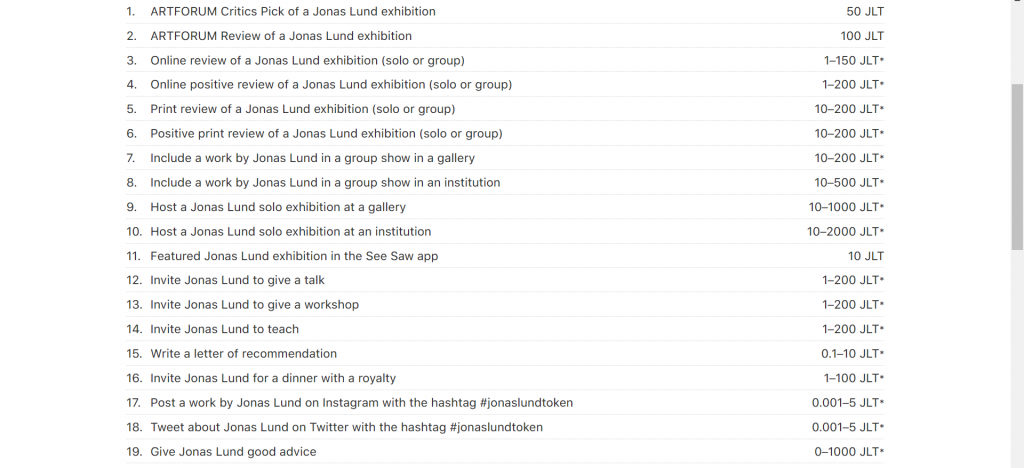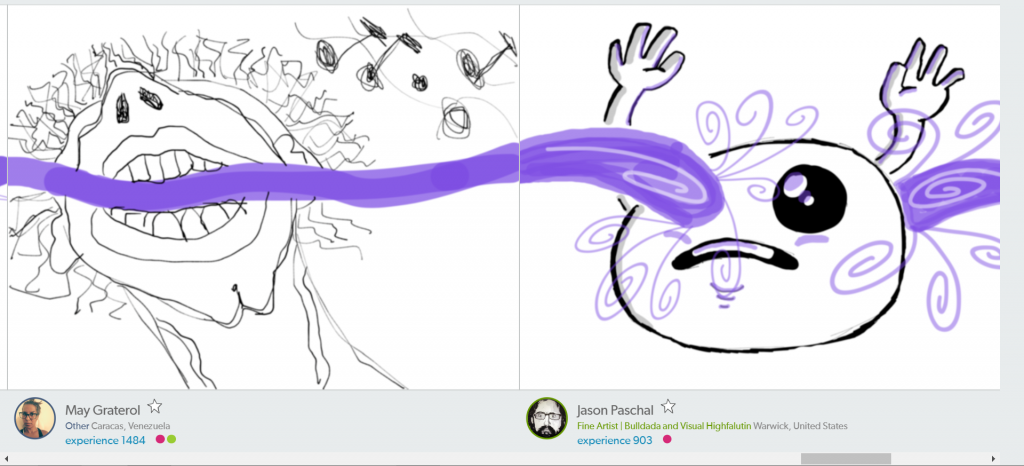What the Jonas Lund Token Tells us About the Curious Convergence of the Art World and Blockchain Technology
The Jonas Lund Token (JLT) is a work by Dutch conceptual artist Jonas Lund, who has created 100,000 shares in his own artistic practice. Each share gives the shareholders agency and voting power over future decisions concerning Lund’s art and the future of the Jonas Lund Token. Each share is represented by one JLT, a crypto-currency built on and distributed via the Ethereum blockchain. The JLT thus explores ideas of art and exchange through the medium of blockchain technology.
As in most shareholder models, one share equals one vote. Owners of the tokens become part of the Jonas Lund’s board of trustees and are consulted each time a decision concerning the project needs to be made via the JLT website.
Of the 100,000 shares, 10,000 were distributed to a select group of art professionals who were invited by Lund to form the initial board of trustees. Lund himself reserved 10,000 JLT with the remaining tokens to be circulated in 3 phases.
In the first phase, 25,000 tokens were made available to the purchasers of physical JLT based art works (figs. 1 and 2). In the second phase, 50,000 shares were made available via a public ICO (initial coin offering). In the third phase, the JLT’s will be traded on a public crypto-currency marketplace, at which point the value of the JLT (previously tied to the value of Ethereum) will be allowed to fluctuate.
The final 5000 tokens are available through the JLT bounty program, in which tokens are offered in exchange for specific actions. These range from posting an image of Lund’s work on Instagram to hosting a Jonas Lund exhibition at an institution or gallery (fig. 3).

What is Blockchain Art
Of course, Lund is not the only artist to experiment with blockchain technology. It could be argued that a hallmark of digital art in general is its drive towards the democratising principles of decentralisation and shared ownership. Think about Instagram accounts that bring art to larger audiences than could ever have been possible in the predigital age. While online communities like deviantart.com make it easier than ever to share and discover new digital artworks.
Another great example of the innovative use of the Ethereum blockchain can be found in dada.art—a website that allows users to “speak” to each other through art. One user starts an artwork, and others can add new panels, encouraging collaborative and spontaneous artistic expression (fig. 4). Digital art is then bought and sold on the platform using the Ethereum cryptocurrency, with the artworks themselves becoming non-fungible tokens based on the Ethereum blockchain, creating verifiable digital exclusivity.

In fact, a whole host of tools and platforms have sprung up that use blockchain technology to make digital art non-fungible, or to enable its authenticity to be verified. Websites like rareart.io and superrare.co use cryptographic keys to create a marketplace for digital art where purchases come with an exclusive digital download, certificate of authenticity and the right to display (cf. O’Dwyer).
In a similar vein, app developer John Watkinson has utilised the Ethereum blockchain to create Cryptopunks—10,000 unique collectible characters. Thanks to blockchain, each character is certifiably unique, you can’t mess with their appearances, and you can track how each one has been bought and sold over time (Klein, 2019).
Art for the People… But not too Many People
Blockchain
technology then, is behind the twin drives towards democratising the artworld and
ascribing value by scarcity. While the general impetus is towards
decentralisation and shared-ownership, there is another way in which such
technologies seem at odds with the peer-to-peer culture of the internet. The
use of blockchain cryptography has reintroduced the concept of rarity into an
online environment that has been used to the free and easy reproduction of
digital goods.
If the internet encourages uninhibited sharing, blockchains allow digital art to become finite, in line with the doctrine of originality that governs the traditional visual art sector. In this new paradigm, shared ownership is encouraged as long as the number of owners is limited.
This is where the JLT is interesting. In allowing token owners to have an element of control over Lund’s creative output in exchange for a fee—or in the case of the bounty program, a favour—he is effectively crowdfunding his future projects. Again, the tendency is towards shared ownership, but this time of the artistic process itself. By creating 100,000 shares that give each shareholder influence and agency over his artistic practice, and by giving up his majority share, Lund subverts the power structures that traditionally characterise the production and dissemination of art.
Artists have always struggled to monetise their art. At a time when the ridiculous excesses of the high-end art market (and the concurrent excesses of a handful of lucky artists—I’m looking at you Damien Hirst!) are enough to make a normal person dizzy, I applaud any attempt to provide alternative funding streams for artists and to allow art fans without six figure budgets to enter into the world of collection and ownership.
Jonas Lund has extended the experimental ethos of artistic expression to the way that we trade art too. The JLT dissolves the distinction between the currency being traded in and the art being traded, and in doing so forces us to think in new ways about the relationship between art and money.
As blockchain technology is applied in ever more original contexts it reminds us of the ways that technology both shapes and is shaped by human societies. Tantalising possibilities include secure online voting (Daniel) and projects like bitsong, which aims to be the worlds first decentralised music streaming platform (Recca et al). I for one look forward to seeing where we will go with these innovations in the future and believe art to be the perfect medium for such an exploration.
References
“Jonas Lund Token (JLT)”. Jonas Lund Token (JLT), 2019, https://jlt.ltd/.
Daniel, Matthew. “Bitcoin News”. Bitcoinmagazine.Com, 2015, https://bitcoinmagazine.com/articles/blockchain-technology-key-secure-online-voting-1435443899.
Klein, Jessica. “How Cryptopunks’ Creators Charmed The Art World And Paved The Way For Blockchain Art”. BREAKERMAG, 2019, https://breakermag.com/how-cryptopunks-creators-charmed-the-art-world-and-paved-the-way-for-blockchain-art/.
Paula Fernández, María et al. There Is No Such Thing As Blockchain Art A Report On The Current Status Of The Intersection Of Blockchain And Art. Acedemia.Edu, 2019, pp. 2-32, https://www.academia.edu/39464761/There_is_no_Such_Thing_as_Blockchain_Art_-_A_report_on_the_current_status_of_the_intersection_of_Blockchain_and_art?auto=download. Accessed 22 Sept 2019.
O’Dwyer, Rachel. Limited Edition: Producing Artificial Scarcity For Digital Art On The Blockchain And Its Implications For The Cultural Industries. Academia.Edu, 2018, https://www.academia.edu/37911167/Limited_edition_Producing_artificial_scarcity_for_digital_art_on_the_blockchain_and_its_implications_for_the_cultural_industries. Accessed 22 Sept 2019.
Recca, Angelo et al. Bitsong: The First Decentralised Music Streaming Platform. Bitsong.Io, 2019, https://bitsong.io/docs/whitepaper_en.pdf. Accessed 22 Sept 2019.